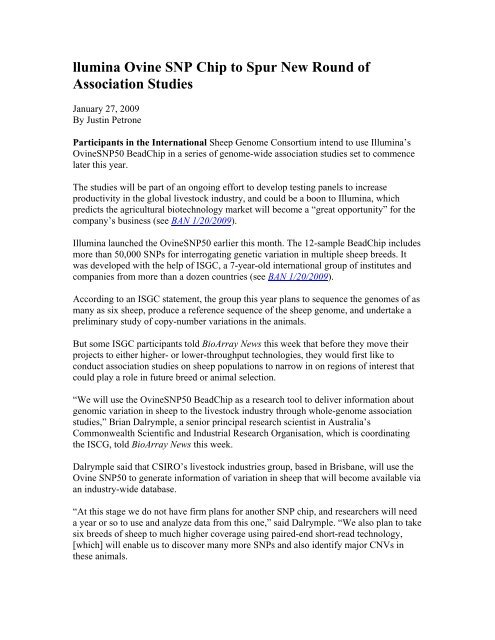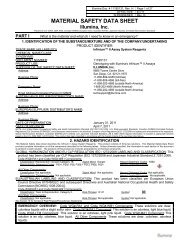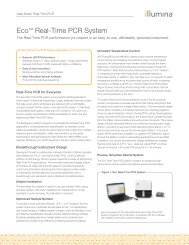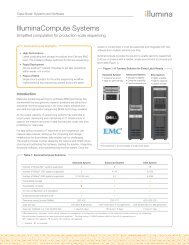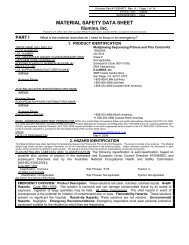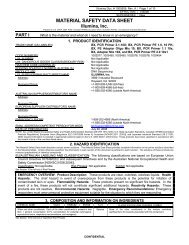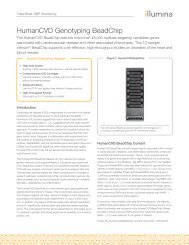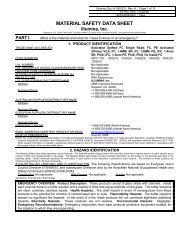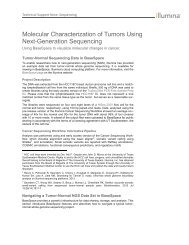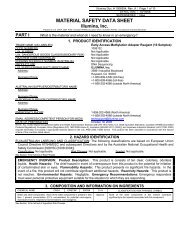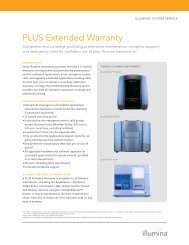Illumina Ovine SNP Chip to Spur New Round of Association Studies
Illumina Ovine SNP Chip to Spur New Round of Association Studies
Illumina Ovine SNP Chip to Spur New Round of Association Studies
You also want an ePaper? Increase the reach of your titles
YUMPU automatically turns print PDFs into web optimized ePapers that Google loves.
llumina <strong>Ovine</strong> <strong>SNP</strong> <strong>Chip</strong> <strong>to</strong> <strong>Spur</strong> <strong>New</strong> <strong>Round</strong> <strong>of</strong><br />
<strong>Association</strong> <strong>Studies</strong><br />
January 27, 2009<br />
By Justin Petrone<br />
Participants in the International Sheep Genome Consortium intend <strong>to</strong> use <strong>Illumina</strong>’s<br />
<strong>Ovine</strong><strong>SNP</strong>50 Bead<strong>Chip</strong> in a series <strong>of</strong> genome-wide association studies set <strong>to</strong> commence<br />
later this year.<br />
The studies will be part <strong>of</strong> an ongoing effort <strong>to</strong> develop testing panels <strong>to</strong> increase<br />
productivity in the global lives<strong>to</strong>ck industry, and could be a boon <strong>to</strong> <strong>Illumina</strong>, which<br />
predicts the agricultural biotechnology market will become a “great opportunity” for the<br />
company’s business (see BAN 1/20/2009).<br />
<strong>Illumina</strong> launched the <strong>Ovine</strong><strong>SNP</strong>50 earlier this month. The 12-sample Bead<strong>Chip</strong> includes<br />
more than 50,000 <strong>SNP</strong>s for interrogating genetic variation in multiple sheep breeds. It<br />
was developed with the help <strong>of</strong> ISGC, a 7-year-old international group <strong>of</strong> institutes and<br />
companies from more than a dozen countries (see BAN 1/20/2009).<br />
According <strong>to</strong> an ISGC statement, the group this year plans <strong>to</strong> sequence the genomes <strong>of</strong> as<br />
many as six sheep, produce a reference sequence <strong>of</strong> the sheep genome, and undertake a<br />
preliminary study <strong>of</strong> copy-number variations in the animals.<br />
But some ISGC participants <strong>to</strong>ld BioArray <strong>New</strong>s this week that before they move their<br />
projects <strong>to</strong> either higher- or lower-throughput technologies, they would first like <strong>to</strong><br />
conduct association studies on sheep populations <strong>to</strong> narrow in on regions <strong>of</strong> interest that<br />
could play a role in future breed or animal selection.<br />
“We will use the <strong>Ovine</strong><strong>SNP</strong>50 Bead<strong>Chip</strong> as a research <strong>to</strong>ol <strong>to</strong> deliver information about<br />
genomic variation in sheep <strong>to</strong> the lives<strong>to</strong>ck industry through whole-genome association<br />
studies,” Brian Dalrymple, a senior principal research scientist in Australia’s<br />
Commonwealth Scientific and Industrial Research Organisation, which is coordinating<br />
the ISCG, <strong>to</strong>ld BioArray <strong>New</strong>s this week.<br />
Dalrymple said that CSIRO’s lives<strong>to</strong>ck industries group, based in Brisbane, will use the<br />
<strong>Ovine</strong> <strong>SNP</strong>50 <strong>to</strong> generate information <strong>of</strong> variation in sheep that will become available via<br />
an industry-wide database.<br />
“At this stage we do not have firm plans for another <strong>SNP</strong> chip, and researchers will need<br />
a year or so <strong>to</strong> use and analyze data from this one,” said Dalrymple. “We also plan <strong>to</strong> take<br />
six breeds <strong>of</strong> sheep <strong>to</strong> much higher coverage using paired-end short-read technology,<br />
[which] will enable us <strong>to</strong> discover many more <strong>SNP</strong>s and also identify major CNVs in<br />
these animals.
“We also plan <strong>to</strong> aim <strong>to</strong> move from draft <strong>to</strong> a reference genome sequence for sheep<br />
heading for as high-quality, close <strong>to</strong> complete sequence as possible,” he added.<br />
Dalrymple added that, as more information becomes available, ISGC participants will be<br />
able <strong>to</strong> access it <strong>to</strong> create “smaller, more focused-trait selection arrays” <strong>to</strong> aid in their<br />
studies.<br />
<strong>New</strong> Zealand<br />
Meantime, in <strong>New</strong> Zealand, the nation’s AgResearch institute hopes <strong>to</strong> genotype several<br />
thousand sheep by summer using the <strong>Ovine</strong><strong>SNP</strong>50, according <strong>to</strong> John McEwan, a senior<br />
scientist at the publicly funded research organization.<br />
“The primary reason that the <strong>Illumina</strong> <strong>SNP</strong> chip was developed is for whole-genome<br />
selection in sheep,” McEwan <strong>to</strong>ld BioArray <strong>New</strong>s this week. “It can also be used for<br />
understanding mutation, breed diversity, [and] helping create linkage maps <strong>of</strong> the<br />
genome, but the primary reason and the vast amount <strong>of</strong> money was invested [<strong>to</strong> make this<br />
chip] because the sheep industry in <strong>New</strong> Zealand wants <strong>to</strong> do whole-genome selection<br />
just like the dairy industry does.”<br />
McEwan said that AgResearch has already genotyped 3,000 sheep and hopes <strong>to</strong> type up<br />
<strong>to</strong> 2,500 additional animals by July. “Our hope is that we will have analyzed those results<br />
and have some commercial tests available in a year’s time” for animal selection, he said.<br />
Any potential tests that come out <strong>of</strong> AgResearch’s association study will be <strong>SNP</strong>-based<br />
and will probably make use <strong>of</strong> the <strong>Illumina</strong> Bead<strong>Chip</strong> or Sequenom MassArray<br />
platforms, both <strong>of</strong> which AgResearch has at its campus in Dunedin. McEwan said that in<br />
the past AgResearch has developed microsatellite and <strong>SNP</strong>-based tests for bovine<br />
selection.<br />
According <strong>to</strong> McEwan, there is “significant” demand for new genetic tests for animal<br />
selection in <strong>New</strong> Zealand, adding that up <strong>to</strong> 10 percent <strong>of</strong> export GDP in the country is<br />
related <strong>to</strong> the sheep industry.<br />
“If you put a ring around sheep and dairy products, you are talking about a very<br />
substantial part <strong>of</strong> <strong>New</strong> Zealand’s income,” McEwan said. “For those reasons, this is<br />
quite an important industry <strong>to</strong> <strong>New</strong> Zealand. An increase in productivity could make a<br />
substantial contribution <strong>to</strong> GDP.”<br />
McEwan said that current selection technologies rely on older techniques like Western<br />
blot <strong>to</strong> identify phenotype and mutation information. With the new <strong>Illumina</strong> chip,<br />
AgResearch hopes <strong>to</strong> identify markers for traits that have been his<strong>to</strong>rically hard <strong>to</strong> select<br />
but that are very important, such as “longevity <strong>of</strong> the ewe, feed intake <strong>of</strong> the ewe,<br />
reproductive ability, how well it milks, disease traits,” and others.
While AgResearch may make headway in its goal <strong>to</strong> develop testing panels this year,<br />
McEwan said that its results will most likely not be applicable in other countries. He said<br />
that limits in current technology suggests that genome-wide selection in animals is<br />
probably only going <strong>to</strong> be applicable within a breed, or a breed and some closely related<br />
cross breeds <strong>of</strong> sheep.<br />
Since most countries around the world produce different sheep breeds, researchers in<br />
those countries will have <strong>to</strong> perform their own association studies <strong>to</strong> produce similar<br />
tests. “It may well be that within five years time, the technology will advance <strong>to</strong> a stage<br />
where a particular group can do research that’s broadly applicable around the world,”<br />
said McEwan, “but <strong>to</strong>day, that is not the case.”<br />
France<br />
While AgResearch prepares <strong>to</strong> genotype 2,500 more animals before summer, plans are<br />
being laid <strong>to</strong> genotype several thousand animals in France. André Eggen, a scientist in the<br />
Animal Genetics Department <strong>of</strong> the French National Institute for Agricultural Research,<br />
<strong>to</strong>ld BioArray <strong>New</strong>s this week that the <strong>Ovine</strong> <strong>SNP</strong>50 will be run on between 3,500 and<br />
4,000 animals this year.<br />
“This will be done for several purposes, especially <strong>to</strong> know a little more about milk<br />
production in sheep and <strong>to</strong> know about parasite and disease resistance in sheep,” Eggen<br />
said. “There is also an interest in specific pro<strong>to</strong>cols about temperament and understanding<br />
more about sheep seasonal breeding cycles.”<br />
In the study, INRA will work with Labogena, a Parisian commercial genotyping lab, and<br />
will use a mix <strong>of</strong> INRA reference populations <strong>to</strong>gether with samples collected from<br />
French sheep breeders. Eggen said that Labogena is already serving the French cattle<br />
industry by genotyping around 10,000 animals per year for selection, but that it will take<br />
time <strong>to</strong> develop similar panels for use in sheep due <strong>to</strong> data analysis challenges.<br />
“You have <strong>to</strong> apply the right statistical model <strong>to</strong> the data as well account for the pedigree<br />
<strong>of</strong> the sheep, so it will take several months alone <strong>to</strong> do the analysis,” Eggen said. In terms<br />
<strong>of</strong> the panels, Eggen said that current technology, including <strong>Illumina</strong>’s <strong>Ovine</strong><strong>SNP</strong>50, will<br />
not permit affordable, high-volume genotyping <strong>of</strong> markers in sheep, but that several<br />
platforms in development look promising.<br />
“You want <strong>to</strong> have a system that allows you <strong>to</strong> genotype a few hundred markers at a very<br />
cheap price because sheep are not <strong>of</strong> as high an economic value in France as, say, cattle,”<br />
he said. “This genotyping technology is not out yet, but it is coming and we hope it will<br />
become available later this year.”<br />
He declined <strong>to</strong> discuss which platforms he intends <strong>to</strong> use, but said that he knew <strong>of</strong> <strong>to</strong>ols in<br />
development at both <strong>Illumina</strong> and Life Technologies that could serve such purposes.
Eggen added that due <strong>to</strong> INRA’s previous experience with Labogena in serving the cattle<br />
industry, it would likely follow a similar model when it came time <strong>to</strong> implement animal<br />
selection testing for sheep breeders.<br />
“The industry sends blood samples from young calves <strong>to</strong> Labogena [which] performs the<br />
genotyping, and INRA compiles a genomic index assessing the genomic value <strong>of</strong> an<br />
animal,” Eggen explained. “The industry can then select the young calves they want <strong>to</strong><br />
raise and produce semen from. That is a way in which we have implemented such a<br />
program within the industry.”<br />
Israel<br />
ISGC participants from countries with smaller industries also have plans <strong>to</strong> conduct<br />
similar studies, albeit on a lesser scale. According <strong>to</strong> Elisha Gootwine, a scientist in the<br />
Agricultural Research Organization, the research arm <strong>of</strong> the Israel Ministry <strong>of</strong><br />
Agriculture, plans are being made at the ARO’s Institute for Animal Science in Bet<br />
Dagan <strong>to</strong> genotype several breeds <strong>of</strong> Israeli sheep.<br />
He said that ARO is now collecting samples from three different breeds and hopes <strong>to</strong><br />
outsource the genotyping <strong>to</strong> CSIRO’s facilities in Brisbane. ARO and CSIRO will work<br />
<strong>to</strong>gether <strong>to</strong> analyze the resulting data.<br />
“We hope <strong>to</strong> get information regarding breed diversity and how breeds differ from other<br />
breeds in the world,” Gootwine <strong>to</strong>ld BioArray <strong>New</strong>s this week. “By comparing the<br />
markers on the genome, we can see how breeds are similar and in what regions they are<br />
similar <strong>to</strong> other breeds. By collecting samples, we can also collect data on how animals<br />
differ in certain productive traits.”<br />
Gootwine noted that agriculture accounts for about 2.5 percent <strong>of</strong> Israeli GDP, part <strong>of</strong><br />
which is derived from exporting sheep milk and meat. “We have both dairy production<br />
and lamb production in Israel,” he said. “It is not a big business, but some people live on<br />
sheep production, and that is why we are working on it.”


